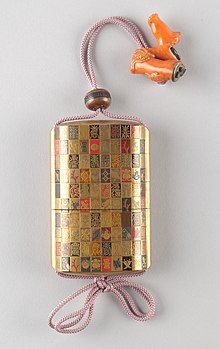
An inro (印籠, Inrō, lit. "stamp case") is a traditional Japanese case for holding small objects, suspended from the obi (sash) worn around the waist when wearing a kimono. They are often highly decorated with various materials such as lacquer and various techniques such as maki-e, and are more decorative than other Japanese lacquerware.[1][2]
Because traditional Japanese dress lacked pockets, objects were often carried by hanging them from the obi in containers known as sagemono (a hanging object attached to a sash). Most sagemono were created for specialized contents, such as tobacco, pipes, writing brush and ink, but the type known as inro is suitable for carrying small things, and was created in the Sengoku period (1467–1615) as a portable identity seal and medicine container for travel.[1][2]
In the middle of the Edo period (1603–1868), inro became popular as men's accessories, and wealthy merchants of the chōnin and samurai classes collected inro often beautifully decorated with lacquer. As the technique developed from the late Edo period to the Meiji period (1868–1912) and the artistic value of inro increased, inro were no longer used as an accessory and came to be regarded as an art object for collection.[1][2]
The term inro is a combination of the kanji for in (印), which means a seal or stamp, and the kanji for rō (籠), which means a basket.
- ^ a b c Masayuki Murata. 明治工芸入門 pp. 104–106. Me no Me, 2017 ISBN 978-4907211110
- ^ a b c Yūji Yamashita. 明治の細密工芸 pp. 79–81. Heibonsha, 2014 ISBN 978-4582922172